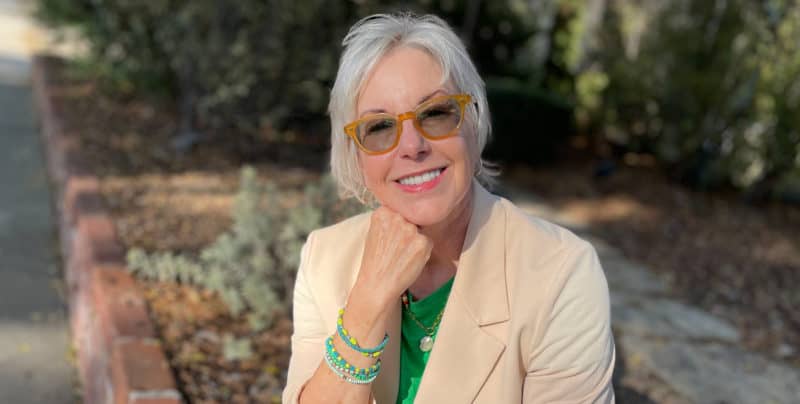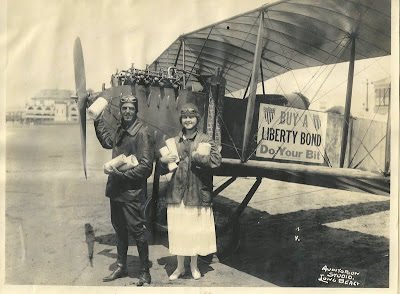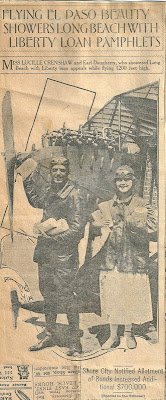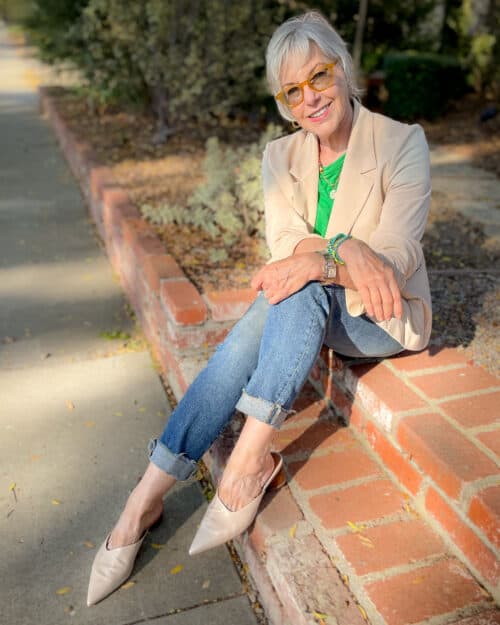encore: family, known and unknown
Today would have been my Grandmother’s 115th birthday. She saw and did so many amazing things, many of which I never knew until years after her death. Here’s a re-post of one of them, (originally posted in July 2011).
Above is a picture of my Grand-mère Lucille at the age of 17, having just flown over Long Beach dropping Liberty Bond leaflets from the open cockpit of an airplane. The year was 1917.
I had no inkling she’d done this until last year, when my sister and I were sifting though boxes upon boxes of our dad’s papers and personal belongings. We unearthed some dusty gems of family history, most of which unfortunately are now missing context, and there is no one left who can fill us in. My grandmother was never one to talk much about herself or her life. The last few years she was alive and still able to engage in extended and focused conversation, I tried to get her to open up about her life and family history but our visits were short and infrequent (I lived a few hundred miles away) and I never was able to amass much information, as she remained fairly buttoned up despite my inquiries. Mostly, I’m sorry I never got to know about the kind of young woman she’d been, what she’d seen and done and dreamed.
By the time my sister and I were old enough to be aware of her, she was in her early 60’s and seemed to have mostly settled into a solid propriety. She always was in a dress and hose, her lipstick always applied (but never nail polish). She chided my mother when she felt that my sister and I weren’t demonstrating properly ladylike behavior. So it was interesting to learn years after her death that she’d been rather a bit of a “wild child” for the time. She’d been kicked out of the first college she attended (U of Colorado, Boulder) allegedly for partying too much, though no one ever knew the full story. (She later went on to graduate from U.C. Berkeley.) And now, I find that she took her first flight as a teenager, when flying itself had only been possible for a decade.
I wish she’d shared more of this side of her. We saw glimpses at times, sometimes a snippet of sly humor or even silliness. A bit of it resurfaced during her 60’s after the death of my grandfather, when within the space of a few years she took several trips to the far corners of the world (in tour groups, and I’m certain, in no small degree of comfort), after which she never traveled again. She seemed content to putter around her apartment and small patio garden, have lunch with friends, and read the newspaper. I wonder about the influences and pressures that perhaps molded her into the more constrained, conventional woman we knew. I wonder if she felt repressed, or if she was comfortable in that persona, looking back on her youthful adventures as a phase she was relieved to have survived with no lasting consequences. Did that intrepid young woman remain a part of her identity?
Are there ancestors you wish you knew more about? Have you discovered any surprising information about those in your family tree?

Stay in touch
Sign up to be notified of new posts and updates from une femme d’un certain âge.




I can see how your grandmother is a mystery. I love the photo of her in her flying gear.
My grandmother came from Poland in the early 1900s as a young woman of nineteen. She came alone, but in her trunk was lace for a future wedding dress. Because she did not speak English, and I did not speak Polish, our communication was limited. We did share a bedroom for most of my childhood. I do know that she came from the rural area around Krakow, Poland and that she had never had the opportunity to go to school. I see her as very brave for coming to the United States alone as a very young woman.
What a great post. I am currently immersed in family history from many angles. My mom was abandoned at birth in 1930 and through the magic of DNA, we have just located a first cousin and might even ID a birth parent when another cousin tests. They, too, are from Poland–we had no idea.
On the other side, my paternal aunt has dementia and her daughter had boxes of photos, so I offered to scan them. I’m at about 6K photos so far (my cousin’s and my aunt’s). Then her brother and his wife ended up in a nursing home, and we helped my other cousin clean out his parents’ home of nearly 60 years. He had been involved in genealogy since the 1960s, so I picked up boxes and boxes of letters and research, plus another 2K or so photos. He is helping ID the photos, but I have learned so much about all sides of my family from this, plus I’m able to share the scanned images with everyone.
My uncle was enlisted in the Navy and was a couple days from becoming an officer and entering flight training when the program was cancelled. He remained enlisted while his brother became an officer. I learned they had always been competing, and felt like he had come second yet again.
I learned more about my mom’s wild side too, and she ended up rather strict and uncompromising in her 40s and beyond, but not as formal as your grandmother.
The old photos are awesome, aren’t they? And it was hard work, cleaning out that old house, but so rewarding to discover them and be able to share.
Love your blog…this topic fits so perfectly with my blog and anthology. TheCharmChest.com
“If you look deeply into the palm of your hand, you will see your parents and all generations of your ancestors. All of them are alive in this moment. Each is present in your body. You are the continuation of each of these people.” Thich Nhat Hanh, Vietnamese Monk, Activist and Writer.
The hours I spent exploring my great-grandmother’s charm chest inspired the theme of my life work. It was later that I learned to value and honor the wellspring of meaning I hold within my being, the treasure chest of charms I continue to accumulate on my journey.
As the eldest of the three siblings, in my family I held a position of great privilege. Although I was poorly mothered, my early years were nurtured in the nest of Larson love I was born into. I was my paternal great-grandparents’ first great-grandchild and also the first grandchild of their son who died at 28 while piloting his plane over Texas, leaving behind two children, including my father.
For five years I saw my great-grandmother almost daily. She called me her jewel. She was a gentle and dignified woman of pioneer stock. In her quiet gentility, she embodied great resolve and bore her profound grief with quiet forbearance.
I knew her as Grandma Lew. I often heard the family legend about her making her husband’s law school education possible. Because he worked nights as an accountant and attended classes by day, although she was a young mother with two sons, she read his law textbooks aloud to him after he got home from work while he rested his eyes and listened.
She died as I was starting kindergarten, we were both making passages into our ever-expanding worlds. When I was fifteen, a fledgling feminist, I read a newspaper article about her husband Lewis Larson and learned that her real name was Laverna. Imagine learning that she’d worked as a suffragette on a state level and yet sacrificed her real name to be known as Grandma Lew to her husband’s Grandpa Lew. She had allowed her identity to become completely subsumed by her distinguished husband.It was no longer a mystery why she lived with her velvet draperies drawn, smoked cigarettes only in private, and grew her extravagant garden behind closed gates, her secret world. She was a hidden woman, her womanhood hidden.
But in the five years we shared she brushed and braided my hair; helped my father teach me to read; introduced me to the mysteries of her charm chest, the delights of her garden, the mysteries of golden apples and the alchemy of stirring the pots on her kitchen stove.
Her life was lived largely in the shadow of a distinguished husband. And she remains a woman forgotten by history.
It was Laverna who read her husband Lewis’s law school textbooks outloud to him while he rested his eyes after leaving his night job as an accountant. And although she was largely responsible for his exemplary scholastic and courtroom accomplishments, history only remembers his flamboyant style.
It was Laverna who made their home a haven of beauty and style.
It was his law library that received national recognition.
Laverna was a suffragette.
History remembers the powerful defense attorney.
Her story has never been written. The beauty of her gardens has been forgotten.
Yet the flowery eloquence of Lewis Larson’s words lives on in text books.
As I think of her I’m reminded of a life lived with dignity, a life marked by meaning, a self-referred life defined by grace, resilience, and beauty.
In the quantum physics theory of conservation of information we come to understand that once an entity has existed the imprint it made is eternal, for it has inalterably changed everything it touched.
I was touched by Laverna’s presence and I am proud and grateful that she is in my lineage of women of once upon a time.
Most of my memories of her are from feelings that were imprinted on my young soul. Images of her and her home and garden flitter in and out of my awareness, my stories and dreams. I was too young to remember and understand her every word, but her influence on my life and writing has been profound. I believe the contents of her charm chest was the inspiration for my successful career as a jewelry designer. It is because of Laverna that I returned to the garden in a time of sadness. It is Laverna’s essence that my readers have met in my books; she was the inspiration for the wise crone voices of Rita Auldney, Lei Shamilly, La Shamana, and Tilly Monroe.
She was the most profound inspiration for my life work. I was influenced grandly by what she said and did, but more so by what she didn’t say and do.She didn’t work as a suffragette for herself, this is obvious. She worked for me, for all of her progeny who followed. Today, when we create, we do so in behalf of a foremother who worked for our privilege of freedom of expression. For that reason this project is dedicated to Laverna Larson, formerly known as Grandma Lew. I believe she smiles at my audacious correction of herstory.
Our relationship is ongoing. Just two nights ago I dreamed she patted my cheeks and said, “Write my story.” And so today as I turn the key to her charm chest, I’m confident Grandma Laverna is whispering to me across the unfurling tapestry of time and space.
It does not matter that I will never know the siren songs I did not hear or where the temptations of other paths might have taken me. Early in life, the theme of my journey was set forth by Laverna’s gentle revelations and gentile teachings that she continues to share in our sojourns into the repository of meaning of her charm chest.
Sunday
Eloquent and moving. Thank you for that post.
I’m enjoying hearing these diverse family narratives! By the way, I think it’s quite conceivable that your aviatrix grandmother considered her life all of a piece– both the “conventional” and the less conventional. Fascinating!
My Dad’s side of the family were impoverished English and Welsh stone masons, coal miners, and one was a seamstress in the court of Queen Victoria. They didn’t emigrate to the New World until the early 1900’s.
We always knew part of my Mother’s side were Huguenots (French Protestants) who fled persecution in the Alsace-Lorraine area, probably in the 1600’s. Interestingly, they settled in Catholic Ireland, where they also prospered. They were linen merchants and violin makers. There is a persistent theory that they were originally Sephardic (sp?) Jews, named Perez or Peretz, perhaps. Purportedly, in France they ultimately became the Protestant family which produced Claude Pierrais, Parisian violin maker!
Once in Ireland, the name was eventually Anglicized to “Perry”, ultimately resulting in the well-known eighteenth century violin maker Thomas Perry, who had a studio in Anglesea Street in Dublin.
It’s humbling to have an inkling of the great struggles, setbacks, and yet courage and persistence found in all of our family histories. I adored both of my parents and had to “pry” stories out of them, which were later confirmed by my sister’s intrepid genealogical investigations.
My mother would have been 106 this year. She had me in her early 40s. She was British and the oldest of her siblings. At 14 she left school and went to work to help support her family. Her father served in the trenches in WWI and, as she later recounted, never ever spoke about it after his return. War was to figure large in her life as one of her brothers was in the Royal Navy long before the war started. He served around the world which included many Asian countries such as China during the Boxer War in the 30s, South America and many others. But Mom lived in London, and September 3,1939 brought the news of Britain at war with Germany–the beginning of WWII and a month later the death of her father. She was now supporting her mother and a younger sister. Another brother was married. In July 1940, her Royal Navy brother was killed when a U-Boat sunk his ship in the North Atlantic. The Blitz arrived in September and by that time, my mother working two jobs: one, as a member of the St John’s Ambulance Service – driving ambulances during raids, going through rubble to find victims and transporting them, sometimes many in at one time, to hospitals; and, secondly, as a trunk line operator (long distance) though she never spoke about it until she was in her 80s as she had worked in a classified, underground position. Her home was bombed during the Blitz, but the family kept on as best they could until repairs could be made. She eventually met my father in the UK and they married a month before the war ended in Europe. She was 36. Mom sailed from the UK on the Queen Mary to the US in 1946 to join my father for life in the US…but not for long. My father returned to the military and from the early 50s on we lived overseas for most of the next 15 years. Mom was always ready to move, ready for travel and exploration–we did it constantly and we loved it because she loved it and shared her joy. She continued to travel, even in her later years. An avid reader all her life, eater of cheese sandwiches and drinker of tea with milk and sugar (…please, “coffee was for foreigners”, a favorite statement of hers), she was a remarkable woman.
When you consider what the world looked like in 1909, the year of her birth, and what it was like in 1999, the year of her death, it is amazing to consider, like your grandmother, all the amazing changes, from fashion to industry, they saw in their lifetimes.
What a great post Susan! My maternal grandmother would have been 114 this year, she was a woman of keen intellect who was only able to go to school until she was 14 (family circumstances) but she never stopped reading and learning. She died of breast cancer when I was 7 and she was 62 but my memories of her are comforting and abiding.
I loved reading this again; the story of an intrepid woman always fascinates. At my mother’s 90th birthday party a model of rectitude had a couple of drinks (and possible medication interaction?) and spilled the beans to me about several pillars of the community, in my childhood. Mostly about who was whose mistress, etc. They seemed so proper to me, but I learned not all of them were.
Isn’t genealogy fascinating? I’ve been working off & on at it for years; I have no famous or particularly accomplished ancestors, but I still find the details so interesting. I solved half a family mystery that my Grandma would never talk about, but will probably never be able to figure out the rest of it. Suffice it to say Grandma had good reason to be so close-mouthed!
I also discovered that I come from a long line of shoe- and boot-makers, which explains a lot!
Interesting post and thank you for sharing this with us. I wished my parents talked more about their childhood but being in China during all the turmoil was extremely difficult for them and they never talk about it to us. I know little about what they went through but know that my mom saw my grandfather being killed and she was forced to to move to Hong Kong to take care her aunt’s kids because my grandmother could not afford to feed so many kids. I know this sounds so depressing and I can’t imagine what my mom’s been through and it’s probably to painful for her to share with me. My mom is a wonderful strong woman and I am always amazed at all the adversity that she’s been through.
Alice
http://www.happinessatmidlife.com
Hope to see you for TBT Fashion link up.
Beautiful post. I still miss my maternal grandmother so much. I talked to her everyday on the phone, and went to her home often. She died 30 years ago, and at times I still pick up the phone to call her with news.
My mom has been doing a lot of family research and recently discovered that my great-great grandparents lived in Manhattan! After a lifetime of considering myself rootless since I was a Navy brat, it turns out I’m a native New Yorker after all. How fun! Great post and I love that picture of your grandmother!
Jill
It would be even crazier if it turned out we were related!
What a lovely post! I felt myself wishing along with you that she had shared some of that wildness with you! Thanks for the wonderful tribute to your grandmother.
My grandmother was born in 1902, and had lots of wonderful stories…riding on a motorcycle (in a white pleated skirt!), trying out for a vaudeville show and working in a chocolate factory (she got to take home the “mud”…pieces that weren’t good enough to sell). She lived to be 93, and at her funeral the nun who had brought her communion when she couldn no longer go to Mass told us all of how Grandma was perfectly turned out for her visits: hair in a french twist, red lipstick and a smart dress. She was a great inspiration to us all.